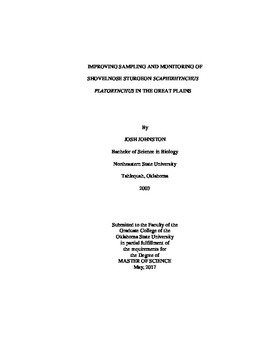| dc.contributor.advisor | Brewer, Shannon K. | |
| dc.contributor.author | Johnston, Josh | |
| dc.date.accessioned | 2018-03-13T18:15:53Z | |
| dc.date.available | 2018-03-13T18:15:53Z | |
| dc.date.issued | 2017-05-01 | |
| dc.identifier.uri | https://hdl.handle.net/11244/54545 | |
| dc.description.abstract | Abstract: Abstract: Shovelnose Sturgeon is the most abundant sturgeon in North America, but their abundance has declined over the past century. Extirpations have occurred in some areas, and some range-edge populations are now isolated. Isolated populations of Shovelnose Sturgeon in the Arkansas River and Red River basins of the southern Great Plains represent the southwest extent of the species current range. The conservation and management of Shovelnose Sturgeon in this region will hinge on our knowledge of the current distribution, and the development of successful sampling strategies. Therefore, our objectives were to: 1) identify factors related to the current distribution of Shovelnose Sturgeon within the Arkansas River and Red River basins, and 2) synthesize existing sampling methods and strategies for Shovelnose Sturgeon throughout the range, and then test the usefulness of several of those methods for capturing Shovelnose Sturgeon in the Arkansas River, Oklahoma. The distribution of Shovelnose Sturgeon in the Arkansas River basin was primarily related to mean annual discharge, but the Red River basin distribution was mostly related to the extent of available habitat and discharge. Both populations were negatively correlated with elevation as expected by big-river fishes. Our model results showed bias resulting from existing sampling strategies, but provided a path forward for monitoring efforts. We reviewed 100 papers that reported the capture of Shovelnose Sturgeon in 12 rivers using 12 different gears or techniques. Benthic trawls were used most often, but mean catch was highest using stationary gillnets. High uncertainty in the number of sturgeon captured among gears, and studies, and the use of multiple gears in nearly half of the studies, suggested difficulties in sampling sturgeon. We had very limited success capturing Shovelnose Sturgeon in the Arkansas River using gears and methods reported in the reviewed studies. Thus, we developed a hybrid method using trammel nets, while flows were manipulated by water-management agencies. We captured 26 Shovelnose Sturgeon in five days using our hybrid method, the most successful method used. Results from this study will be used to provide insight into future study designs, and advise future study objectives. | |
| dc.format | application/pdf | |
| dc.language | en_US | |
| dc.rights | Copyright is held by the author who has granted the Oklahoma State University Library the non-exclusive right to share this material in its institutional repository. Contact Digital Library Services at lib-dls@okstate.edu or 405-744-9161 for the permission policy on the use, reproduction or distribution of this material. | |
| dc.title | Improving Sampling and Monitoring of Shovelnose Sturgeon Scaphirhynchus Platorynchus in the Great Plains | |
| dc.contributor.committeeMember | Shoup, Daniel | |
| dc.contributor.committeeMember | Long, James | |
| osu.filename | Johnston_okstate_0664M_15142.pdf | |
| osu.accesstype | Open Access | |
| dc.description.department | Natural Resources and Ecology Management | |
| dc.type.genre | Thesis | |
| dc.type.material | text | |
